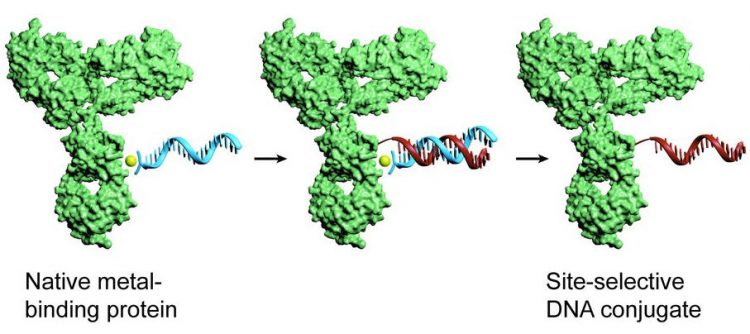New method provides researchers with efficient tool for tagging proteins

With a new method, researchers use a piece of DNA engineered to bind to metal ions. Using this ‘control stick’, they direct another piece of DNA to a metal binding site on the protein. Illustration: Nature Chemistry
DNA linked to proteins – including antibodies – provides a strong partnership that can be used in diagnostic techniques, nanotechnology and other disciplines. DNA–protein conjugates – which tag proteins with DNA – can be used for purposes such as the sensitive detection and visualisation of biological material. The method also provides easier access to handling proteins in nanotechnology, where the DNA acts as a handle on the protein.
Controlling the conjugation of macromolecules such as DNA and proteins can be quite a challenge when scientists want to join them in particular ways and places. Researchers at Aarhus University have now developed a new and efficient method to tag proteins with DNA, making it much simpler to control the process than previously. The new method was developed at the Danish National Research Foundation’s Centre for DNA Nanotechnology (CDNA) in collaboration between researchers at Aarhus University’s Interdisciplinary Nanoscience Centre (iNANO), Department of Chemistry and Department of Molecular Biology and Genetics. The work is described in the highly prestigious scientific journal Nature Chemistry.
“Maintaining the protein’s function and activity often requires the attachment of only a single DNA strand to the protein. At the same time, it can be important to know where the DNA strand is attached to the protein. You can normally only achieve this if you are working with genetically engineered proteins. This is a time-consuming and technically challenging process,” explains PhD student Christian B. Rosen, CDNA, Aarhus University – one of the researchers behind the new method.
The new method makes it possible to direct the tagging of proteins with DNA to a particular site on the protein, without genetically modifying the protein beforehand. In other words, it is possible to tag natural proteins, including antibodies.
The researchers use a piece of DNA that is engineered to bind to metal ions. Using this ‘control stick’, they direct another piece of DNA to a metal binding site on the protein, where it reacts. A considerable number of proteins bind metal ions, which makes them suitable for this method. A significant point in using this method is that the tagged proteins retain their functionality after being bound to DNA.
The researchers are applying for a patent for the new method, which has potential in a number of areas.
“Of greatest importance is the fact that we can use our technique for tagging antibodies. Antibodies that are chemically bound (conjugated) to chemotherapeutics represent an entirely new class of medicine in which the antibody part is used to recognise specific tissue and the chemotherapeutic part is used to kill the cell. When you tag antibodies, it’s important that you keep the recognition element of the antibody intact. With our method, we strike the constant part of the antibody and not the variable part, which contains its recognition element. Our technique is therefore general for a major class of proteins,” explains Anne Louise Bank Kodal, CDNA, another author of the article.
The researchers are working on further developing the method so they can attach chemotherapeutics to antibodies and not just DNA.
Read the article in Nature Chemistry.
For more information, please contact
PhD student Christian B. Rosen
CDNA at iNANO and Department of Chemistry
crosen@chem.au.dk
PhD student Anne Louise Bank Kodal
CDNA at iNANO and Department of Chemistry
alkodal@chem.au.dk
Postdoctoral Fellow Thomas Tørring
CDNA at iNANO (currently at Yale University, USA)
thomas.torring@yale.edu
Professor and Director Kurt Gothelf
CDNA at iNANO and Department of Chemistry
kvg@chem.au.dk
Media Contact
All latest news from the category: Life Sciences and Chemistry
Articles and reports from the Life Sciences and chemistry area deal with applied and basic research into modern biology, chemistry and human medicine.
Valuable information can be found on a range of life sciences fields including bacteriology, biochemistry, bionics, bioinformatics, biophysics, biotechnology, genetics, geobotany, human biology, marine biology, microbiology, molecular biology, cellular biology, zoology, bioinorganic chemistry, microchemistry and environmental chemistry.
Newest articles

Webb captures top of iconic horsehead nebula in unprecedented detail
NASA’s James Webb Space Telescope has captured the sharpest infrared images to date of a zoomed-in portion of one of the most distinctive objects in our skies, the Horsehead Nebula….

Cost-effective, high-capacity, and cyclable lithium-ion battery cathodes
Charge-recharge cycling of lithium-superrich iron oxide, a cost-effective and high-capacity cathode for new-generation lithium-ion batteries, can be greatly improved by doping with readily available mineral elements. The energy capacity and…

Novel genetic plant regeneration approach
…without the application of phytohormones. Researchers develop a novel plant regeneration approach by modulating the expression of genes that control plant cell differentiation. For ages now, plants have been the…





















